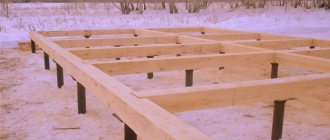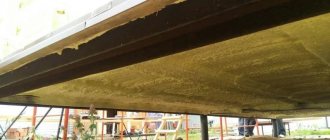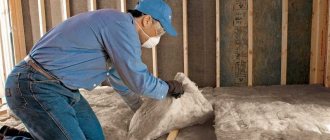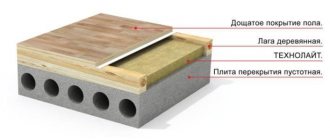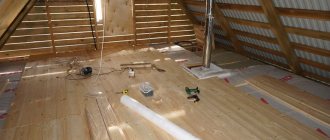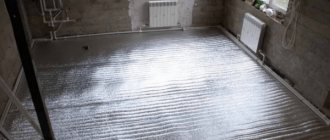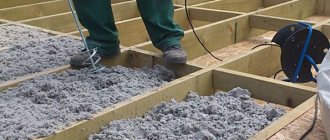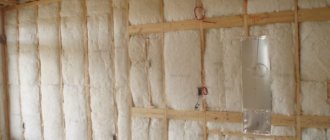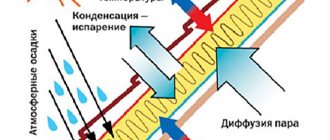The question “Which insulation is better for the floor?” are asked by everyone who loves comfort. It's always nice to walk barefoot without fear that your limbs will freeze. And this is especially true in the off-season, when central heating (if any) is not yet turned on, and in winter, when the temperature outside is sub-zero. It is then that people often turn their attention to floor insulation. We will tell you how to choose the material and how to lay it correctly. After all, a well-insulated floor is one of the components of heat preservation in a living space.
When choosing insulation materials, it is important to take into account the climate zone (how cold it can be in winter), the characteristics of the room and its purpose, the type of existing or planned floor covering. For example, floor insulation in an apartment and in a wooden house will differ significantly.
- 2 Option #2 - expanded clay
- 3 Option #3 - polystyrene concrete
- 4 Option #4 - glass wool and mineral wool
- 5 Option #5 - cork material
- 6 Option #6 - sawdust insulation
- 7 Option #7 - ecowool
- 8 Option #8 - penoizol
- 9 Option #9 - foil insulation
- 10 Additional option - “warm floor” system
Option #1 - polystyrene foam
Among materials that do not require communications or a network connection, the most common insulation for heated floors is expanded polystyrene, well known to everyone as polystyrene foam.
Its thermal insulation properties are 25 times better than those of expanded clay concrete. And walking on a floor insulated with polystyrene foam is much warmer and more pleasant, because such a floor absorbs heat very slowly.
Foam plastic is used as floor insulation when installing a floating screed. Then it is filled with a layer of cement or concrete. You can lay slabs in the gaps between joists when constructing wooden floors. Another way is to lay the slabs on a concrete floor, and on top of them are sheets of plywood.
Expanded polystyrene is not afraid of moisture, so it can be widely used for insulating floors on balconies and in rooms with high humidity levels
Floor insulation with clay
Another amazing and at the same time ancient method of floor insulation, which can still be used in the construction of a garage or cottage, is clay insulation. If you are on a budget, this is definitely the method for you.
Most often, clay is used for insulation in small structures. Previously, it was one of the most common building materials, but now it is used much less frequently. And in vain - in some respects it is much better than the most modern materials.
Floor insulation with clay
One of the main features of clay is its ability to form a dense material and harden under certain conditions. Yes, it needs to be soaked during operation, but then it turns into an almost monolithic block, very strong and reliable.
Now clay can be used to insulate ceilings, floors, and floors in houses. But in order to achieve the maximum level of thermal insulation, it is mixed with straw or sawdust (hardwood or pine). These materials are added directly to liquid clay, from which an insulating layer is then formed. It is best to use white or red clay - these options have excellent porosity and sufficient plasticity, it is convenient to work with them, and the result will be excellent.
What are the advantages of insulating floors with clay? One of the main ones is low cost. Thus, clay is relatively inexpensive compared to a number of other materials on the market. And it’s not difficult to get filler in the form of sawdust - any sawmill will give you as much of it as you want.
Another plus is moderate weight. Clay is not that heavy and does not create strong loads on building structures. It is also non-flammable and will definitely not cause or spread a fire.
On a note! The sawdust inside the clay layer is also not a fire hazard.
Of course, such insulation also has disadvantages. For example, it is not the highest energy efficiency, which is why clay is not suitable for wall insulation. The installation of the clay insulated layer is quite simple, but it still needs to be given time to dry thoroughly before the floors can be used.
The clay is laid on the ground to the level of the lag and compacted well. You can also lay clay up to the floor level, finishing it with tiles or linoleum. In general, if properly arranged, this is a very durable option, practical and completely resistant to moisture. This method of arranging the base when building a garage, shed, cellar, etc. is best suited.
Option #2 - expanded clay
Expanded clay is one of the most accessible inexpensive materials. It is used both when installing dry floor screed, falling asleep under gypsum fiber boards, and added to concrete. Expanded clay is also used to construct a floating floor screed when concrete or cement mortar is poured on top of it.
It is better to insulate the floor with expanded clay from different fractions
The porous structure of this material, made from clay, allows for thermal insulation of the floor even in areas with very cold and frosty winters. But for this, the expanded clay layer should be about 10-15 cm, which is not always convenient, because it reduces the existing living space.
Thermal insulation using the old-fashioned method - sawdust guards the heat
If you need cheap insulation for the floor in the house, it is worth remembering the old-fashioned methods of insulation with sawdust. At the moment, they are slightly improved, sawdust, reinforced with cement, but even in this combination, insulation from sawdust and cement is a cheap option for thermal insulation of the floor in the house.
Recipe for a mixture of sawdust and cement for floor insulation in a house:
for 10 buckets of sawdust, you need 1 bucket of cement, the same amount of lime and half a bucket of water
This is how a mixture of sawdust and cement is made to insulate the floor in the house. With this ratio of components, the mixture turns out thick and dense, it is convenient and easy to spread it on a horizontal floor surface. A similar sawdust mixture can also be mixed using sand, copper sulfate and antiseptics. Sawdust is the basis of such industrial insulation materials as sawdust-based ecowool, arbolite slab insulation, sawdust pellets for home insulation.
Read more about sawdust insulation here: /tehnologiya-utepleniya-pola-opilkami-beznadezhno-ustarela-uteplenie-penopoliuretanom-novejshee-reshenie/
Ecowool insulation
Ecowool can be applied manually or you can use a special professional installation for laying out dry and wet ecowool.
Ecowool can be applied manually or you can use a special professional installation for laying out dry and wet ecowool. For those who make ecowool insulation with their own hands, you need to fill the ecowool manually in the form of a dry mixture. The only thing you should pay attention to is that the automatic method of applying ecowool insulation will save up to 40% of the material. But for one-time use on your own, only the method of manually filling the dry mixture is suitable. The advantage of ecowool insulation is its complete readiness for use. There is no need to add cement, sand, antiseptics, copper sulfate or lime. Ecowool is a sawdust insulation material for the floor and it must be applied between the joists, compacting it.
Option #4 - glass wool and mineral wool
These types of insulation are widely used to insulate roofs, walls and floors due to their low cost. These materials come in the form of slabs or rolls. They are most often used to insulate wooden floors due to the vapor permeability of the material.
Place mineral wool and glass wool between the joists. But the composition of these materials makes us think: the release of dangerous chemicals, although within safe standards, is still present.
Laying mineral wool between wooden floor joists
Glass wool must be carefully insulated so that dust does not enter the room when it wears out. When laying such materials, it is important to leave a ventilation gap. The disadvantages of these materials include their weight and moisture absorption.
Option #5 - cork material
To insulate the floor with a light, safe and thin material, use cork fiber. This is the best insulation for linoleum floors. The best, but also one of the most expensive. In addition to thermal insulation qualities, it is durable and moisture resistant.
Cork material for insulation - modern and fashionable
This material can be laid either as a substrate under floor coverings or used as an independent floor covering. In the latter case, the cork slabs are additionally polished and varnished. You will get a natural, beautiful warm floor.
Universal floor insulation
Universal floor insulation materials made of polystyrene foam or polystyrene foam are still relevant. Pros of polystyrene foam:
- Lightweight floor insulation
Foam plastic is a cheap floor insulation in the house that retains heat well due to its cellular structure filled with air bubbles. - Reliable thermal insulation material
- Easy installation
- Cheap floor insulation
- Environmentally friendly thermal insulation material
Indeed, foam insulation boards have all these advantages. This is a cheap insulation for the floor in the house, which retains heat well due to its cellular structure filled with air bubbles. You can insulate the floor with polystyrene foam yourself. Polystyrene foam is very easy to install. But foam insulation also has a number of significant disadvantages:
- Insufficient material strength
- Increased requirements for foundation preparation
- Sensitivity to moisture
- Short service life
But the most significant disadvantages of polystyrene foam are its accessibility to rodents and low fire resistance.
Option #7 - ecowool
This loose cellulose-based material is used to insulate even hard-to-reach places. It is poured automatically or manually with a layer of 15-20 cm, which in terms of thermal characteristics corresponds to a layer of expanded clay of 80 cm.
Ecowool has soundproofing and heat-insulating properties and is completely safe. But such material is afraid of moisture. Therefore, it is laid only in places where there is no likelihood of increased humidity levels. It is used most often when laying wooden floors.
Option #8 - penoizol
Simply put, penoizol is a liquid foam plastic, all the positive aspects of which we have already talked about. Penoizol is good because, due to its consistency, it can be poured into hard-to-reach places; it can be used to seal cracks and seams.
It is good to use it in the first stages of building and equipping a house. It fills all air voids, thereby preventing the outflow of heat in the future.
In wooden houses, penoizol and its improved version, eco-izol, are poured into the space between the joists
Concrete base insulation options
Depending on the device, the thermal insulation of a concrete floor is carried out using joists or concrete. In the first case, you can use bulk insulation or mineral wool. Due to the fact that the joists take on the main weight of the floor, the load on the material will be insignificant.
When insulating a floor over a concrete base, the main load will go to the heat-insulating layer. In this case, it is better to use extruded polystyrene foam or mineral boards.
Thermal insulation of floors on joists
Insulation along joists is usually done during the construction process. With this method, the height of the room is reduced by the height of the floor (7-10 cm). The concrete base must be dry before laying the insulation. A layer of waterproofing material or polyethylene film is laid on it.
Thermal insulation of concrete floor on joists
Next, logs are installed in increments of 50-60 cm. Heat-insulating material is placed in the space between the logs. The thickness of the insulating material should be a couple of centimeters less than the height of the log. This is necessary for air circulation under the floor. The next stage is the installation of a raised floor (when laying, a 1.5 cm indentation is made from each wall). Chipboard or waterproof plywood are suitable for this purpose. Finally, the floor covering is laid.
Chipboards
Before laying the insulating layer, the dry concrete floor is covered with waterproofing material. Begin laying the slabs at a distance of 1.5 cm from the wall. If this is not done, then under the influence of heat and moisture the slab will expand and deform.
Thermal insulation of floors with chipboards
The insulating material is fastened using dowels. When all the slabs have been laid, the joining gaps are covered with construction mesh. They are then covered with putty and diluted oil paint. A floor covering is laid on top of the thermal insulation layer.
Thermal insulation using the floating floor method
The “floating floors” method received this name due to the lack of connection between the floor and the concrete screed. The insulating substrate is laid first. You can use glassine for this. It must be laid by overlapping one strip onto another with an overlap width of 10 cm. At the junction of the floor and the wall, the glassine should extend slightly onto the wall. The next layer of insulation is made of mineral fiber, polystyrene foam or extruded polystyrene foam.
Installation of "floating floors"
The insulating material is laid close to each other. There should not be the slightest gap between the material. Therefore, it is better to lay two thin layers in opposite directions than one thick one. Using guide rails, the entire structure is filled with concrete mixture. After the concrete has hardened, the guides are removed, and the remaining grooves are filled with mortar.
When pouring a “floating floor”, it is necessary to ensure that concrete does not fall on the walls and screed. Otherwise, the floor will no longer be “floating”.
After the floor has completely dried, it is checked for defects, which are immediately eliminated. Any floor covering is laid on top.
Carpet or linoleum flooring with insulation
Laying carpet on a concrete floor on top of insulation
Before laying carpet or linoleum on insulation, it is necessary to prepare the base. Level the concrete screed. It is advisable to lay polyurethane foam on top. Carpet or linoleum can be glued to the base using bustilate or secured with baseboards. The joints of the floor covering are glued. To make it warmer, you can put an additional layer of felt insulation under the carpet.
Felt-based linoleum
Insulation with isolon
Izolon has a lot of advantages necessary for a thermal insulation material. In addition to its insulating properties, it is lightweight, elastic and resilient. It has almost zero water absorption and high resistance to rotting. This method is good for those for whom insulating the floor with your own hands seems like an impossible task. The installation method is quite simple. Having rolled out the isolon on the floor, it is glued to the base with tape. Self-adhesive isolon coated on one side with glue is available for sale.
Izolon joints are taped
Working with a technical jam
Despite the fact that the thickness of the technical cork does not exceed 1 cm, it is capable of retaining heat for a long time. The small thickness of the product allows you to insulate floors even in two layers, without concealing the height of the room. The method of laying technical cork is the same as isolon. The advantages of this material also include its environmental friendliness, and the disadvantages are its high cost.
Technical cork for thermal insulation of floors
Option #9 - foil insulation
The effect of the material is based on the fact that it reflects heat back into the room, but does not transfer it to the external environment. Therefore, it is correct to lay it with the reflective side up. This material is durable and waterproof, so it can be used in all types of premises, including baths and saunas.
As you can see, there are plenty of materials to insulate your floor, no matter what room it is in. It is important to take into account all the nuances and choose the most effective and safe insulation.
Such insulation may consist of a layer of mineral wool or polystyrene foam and a layer of foil. It is produced in the form of slabs and rolls. They are sheathed on wooden floors or laid under heated floors.
